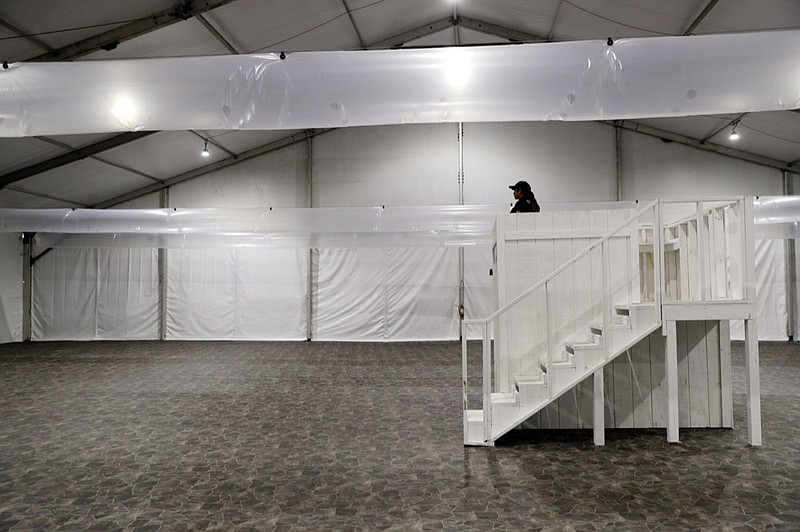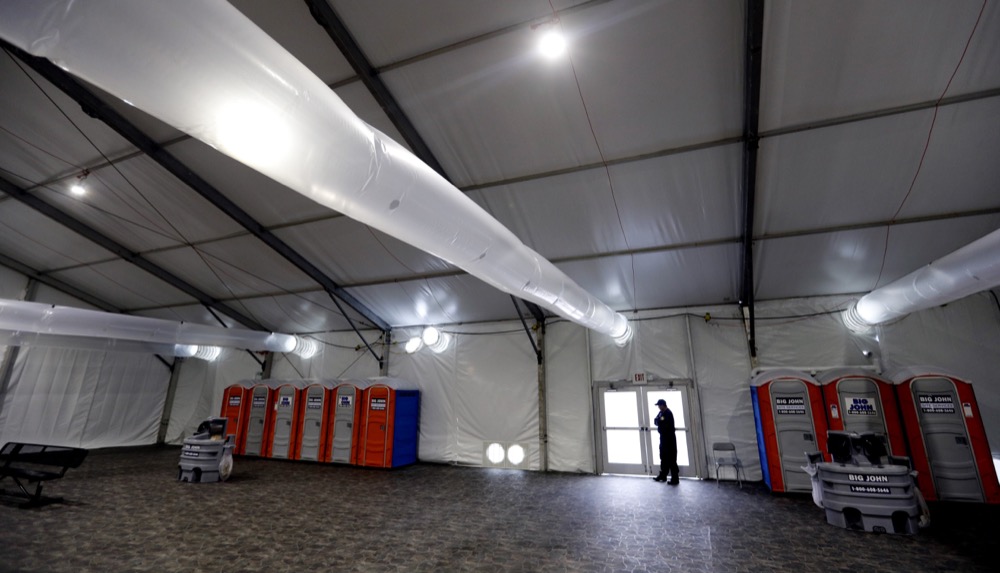 A security guard stands near a doorway to a section of a new U.S. Customs and Border Protection temporary facility near the Donna International Bridge, Thursday, May 2, 2019, in Donna, Texas. Officials say the site will primarily be used as a temporary site for processing and care of unaccompanied migrant children and families and will increase the Border Patrol's capacity to process migrant families. (AP Photo/Eric Gay)
A security guard stands near a doorway to a section of a new U.S. Customs and Border Protection temporary facility near the Donna International Bridge, Thursday, May 2, 2019, in Donna, Texas. Officials say the site will primarily be used as a temporary site for processing and care of unaccompanied migrant children and families and will increase the Border Patrol's capacity to process migrant families. (AP Photo/Eric Gay)
EL PASO, Texas (AP) - About 50 asylum seekers stood this week in a circle near a bridge between the U.S. and Mexico to hear an American attorney explain what would happen to them when they entered U.S. custody.
The attorney, Jodi Goodwin, told them they would probably end up at one of the Border Patrol's smaller stations, which migrants call "la hielera" - Spanish for icebox because of their cold temperatures.
Goodwin advised them to wear their heaviest clothing or borrow clothes from someone else, and to eat a hearty meal before crossing the bridge. In a carrying voice, she repeated in Spanish, "Eat well and dress well."
The advice reflects reality on the border, where a lack of space means some immigrants must sleep on floors in Border Patrol stations, while others are held in military-style tents in El Paso. The government will soon open two more that could start taking immigrants Thursday.
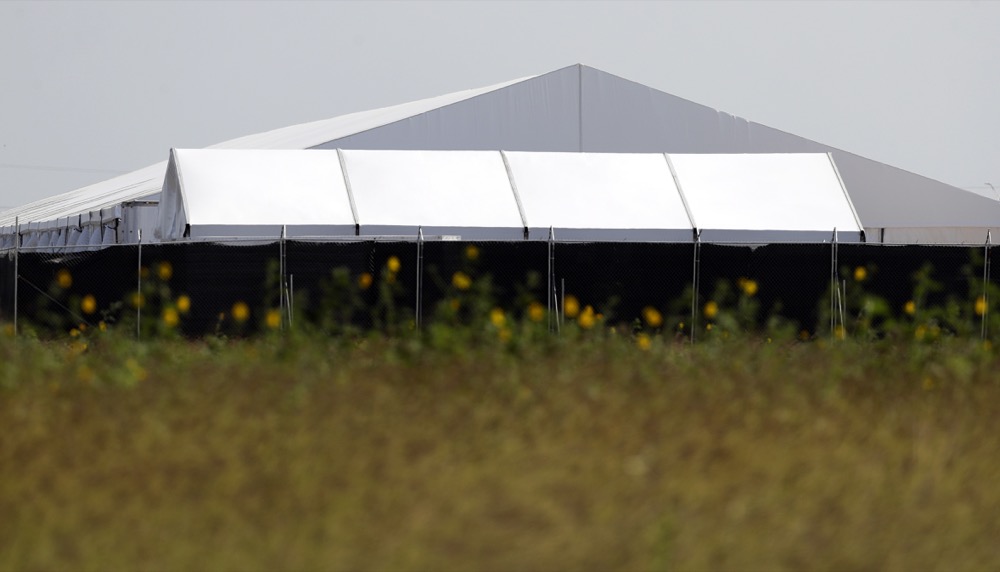 In this May 1, 2019, photo, a U.S. Customs and Border Protection temporary facility is prepared near the Donna International Bridge in Donna, Texas. Officials say the site will primarily be used as a temporary site for processing and care of unaccompanied migrant children and families. (AP Photo/Eric Gay)
In this May 1, 2019, photo, a U.S. Customs and Border Protection temporary facility is prepared near the Donna International Bridge in Donna, Texas. Officials say the site will primarily be used as a temporary site for processing and care of unaccompanied migrant children and families. (AP Photo/Eric Gay)
The newest tent cities - in El Paso and in the Rio Grande Valley - will hold 1,000 parents and families, expanding the Border Patrol's capacity to hold and process the surge of immigrants who have arrived in recent months and overwhelmed authorities. The capacity could be expanded at some point.
"I hope it's enough," said Carmen Qualia, executive officer for the Border Patrol's Rio Grande Valley sector. "We don't know what we don't know."
The tents will offer bathrooms, recreation areas and sleeping quarters that are divided by gender and by families and children traveling alone. Detainees will sleep on mats.
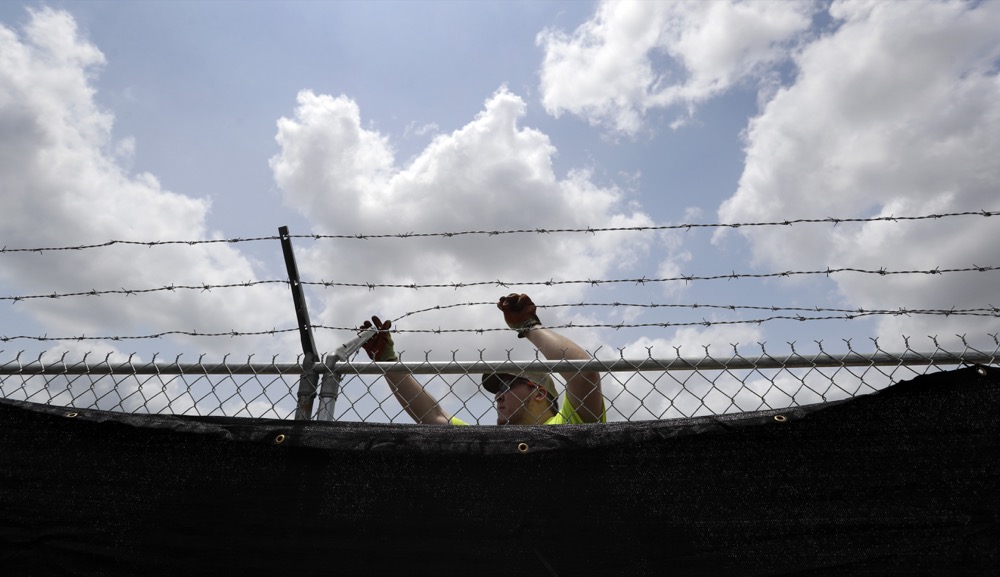 Barbed wire is added to a fence that houses a new U.S. Customs and Border Protection temporary facility near the Donna International Bridge, Thursday, May 2, 2019, in Donna, Texas. Officials say the site will primarily be used as a temporary site for processing and care of unaccompanied migrant children and families and will increase the Border Patrol's capacity to process migrant families. (AP Photo/Eric Gay)
Barbed wire is added to a fence that houses a new U.S. Customs and Border Protection temporary facility near the Donna International Bridge, Thursday, May 2, 2019, in Donna, Texas. Officials say the site will primarily be used as a temporary site for processing and care of unaccompanied migrant children and families and will increase the Border Patrol's capacity to process migrant families. (AP Photo/Eric Gay)
The tent complex in Donna, Texas, is split into four pods, each labeled a different color. In each pod, a private security guard stands watch. Gray sleeping mats are stacked on one side, and portable toilets and sinks are lined up on another. The air conditioning system keeps each pod at a comfortable temperature, but emits a constant humming that can make it hard to hear.
The tents are set to operate through the end of the year, at a cost of as much as $37 million. A contractor in Rome, New York, obtained the bid to build the tents, which the government calls "soft-sided" shelters.
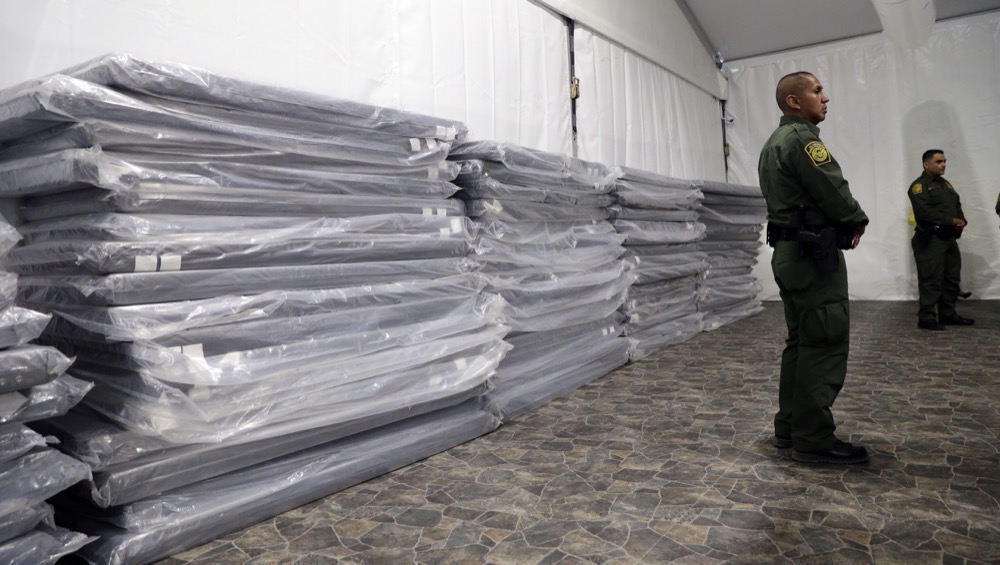 A Border Patrol agent stands near a stack of mattresses during a media tour of a new U.S. Customs and Border Protection temporary facility near the Donna International Bridge, Thursday, May 2, 2019, in Donna, Texas. Officials say the site will primarily be used as a temporary site for processing and care of unaccompanied migrant children and families and will increase the Border Patrol's capacity to process migrant families. (AP Photo/Eric Gay)
A Border Patrol agent stands near a stack of mattresses during a media tour of a new U.S. Customs and Border Protection temporary facility near the Donna International Bridge, Thursday, May 2, 2019, in Donna, Texas. Officials say the site will primarily be used as a temporary site for processing and care of unaccompanied migrant children and families and will increase the Border Patrol's capacity to process migrant families. (AP Photo/Eric Gay)
The Border Patrol's El Paso sector has become the epicenter of the influx of immigrant families from Central America.
On Tuesday alone, agents arrested around 1,100 migrants in the El Paso sector, including 424 who crossed in Sunland Park, New Mexico, according to Border Patrol spokesman Ramiro Cordero. In March alone, the agency apprehended more than 100,000 immigrants, including 53,000 family members.
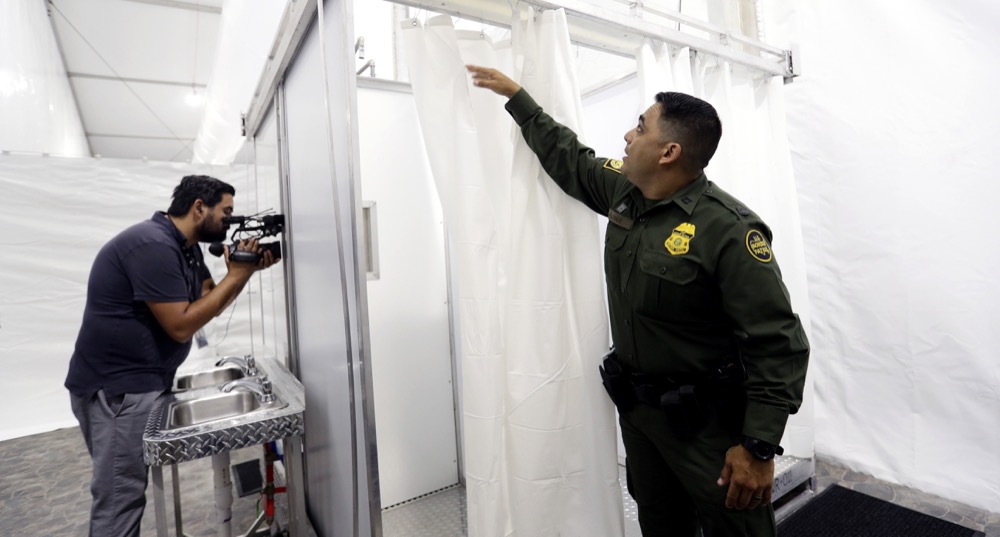 Border Patrol agent E. Flores shows the shower section during a media tour of a new U.S. Customs and Border Protection temporary facility near the Donna International Bridge, Thursday, May 2, 2019, in Donna, Texas. Officials say the site will primarily be used as a temporary site for processing and care of unaccompanied migrant children and families and will increase the Border Patrol's capacity to process migrant families. (AP Photo/Eric Gay)
Border Patrol agent E. Flores shows the shower section during a media tour of a new U.S. Customs and Border Protection temporary facility near the Donna International Bridge, Thursday, May 2, 2019, in Donna, Texas. Officials say the site will primarily be used as a temporary site for processing and care of unaccompanied migrant children and families and will increase the Border Patrol's capacity to process migrant families. (AP Photo/Eric Gay)
The situation has drawn agents away from their traditional duties of patrolling the border and forced Immigration and Customs Enforcement to refuse to hold immigrants because it does not have enough detention space. ICE is dropping large groups of immigrants at bus stations and cities, including Phoenix, San Antonio, Texas, and Albuquerque, New Mexico.
But before the immigrants are handed over to ICE or released, the Border Patrol must process them, and the agency is struggling to keep up.
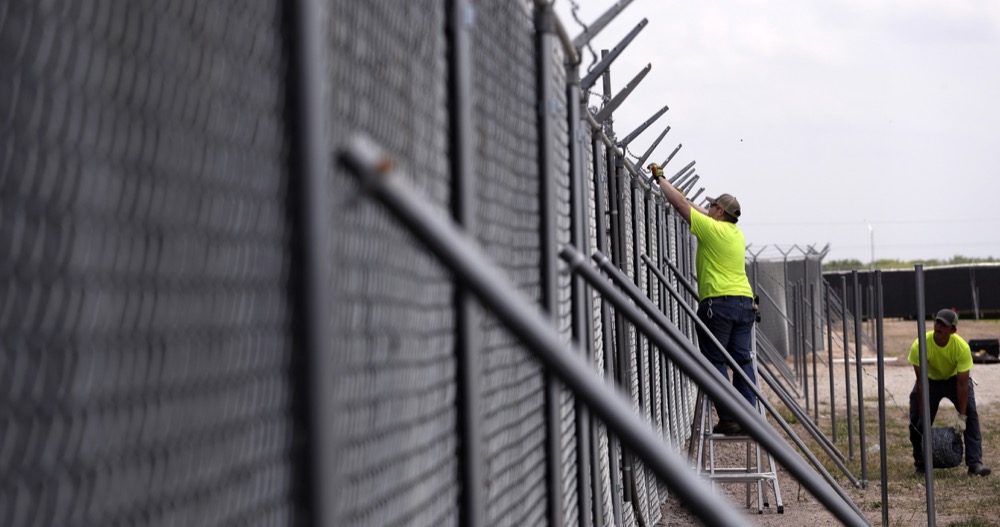 Barbed wire is added to a fence that houses a new U.S. Customs and Border Protection temporary facility near the Donna International Bridge, Thursday, May 2, 2019, in Donna, Texas. Officials say the site will primarily be used as a temporary site for processing and care of unaccompanied migrant children and families and will increase the Border Patrol's capacity to process migrant families. (AP Photo/Eric Gay)
Barbed wire is added to a fence that houses a new U.S. Customs and Border Protection temporary facility near the Donna International Bridge, Thursday, May 2, 2019, in Donna, Texas. Officials say the site will primarily be used as a temporary site for processing and care of unaccompanied migrant children and families and will increase the Border Patrol's capacity to process migrant families. (AP Photo/Eric Gay)
In recent weeks, immigrants have been forced to sleep in hastily constructed tents on top of gravel under a bridge in El Paso. Critics decried the conditions as inhumane and corroborated accounts of migrants who said that they were held too long and did not have access to bedding while sleeping in the cold.
"For far too long, El Paso - America's new Ellis Island, has lacked adequate temporary processing facilities to address the increase in the number of asylum-seeking families arriving at our doorstep," said El Paso Rep. Veronica Escobar, who took fellow Democrats on tours of the bridge setting.
To some critics, the new tents in El Paso and Donna, Texas, are an improvement.
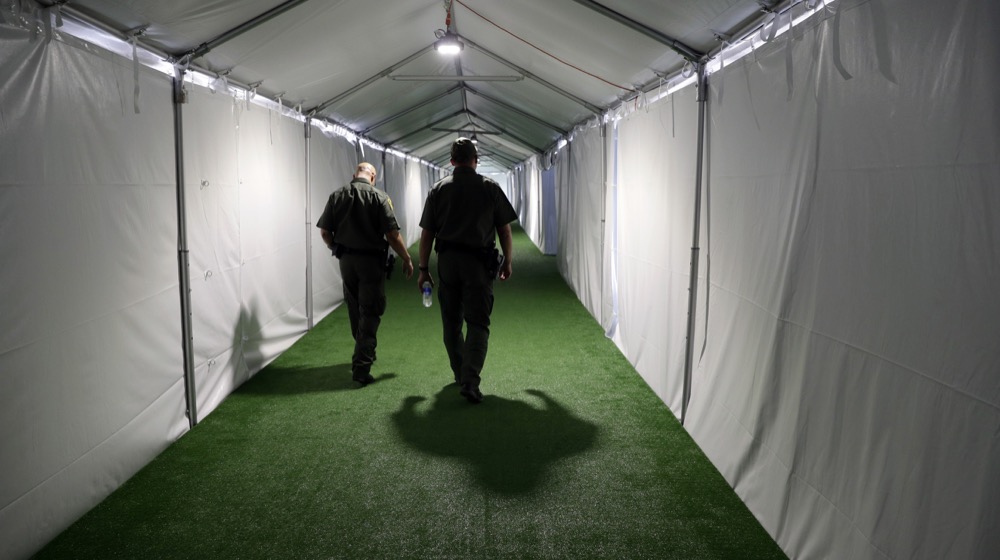 U.S. Border Patrol agents walk down the hallway of a new U.S. Customs and Border Protection temporary facility near the Donna International Bridge, Thursday, May 2, 2019, in Donna, Texas. Officials say the site will primarily be used as a temporary site for processing and care of unaccompanied migrant children and families and will increase the Border Patrol's capacity to process migrant families. (AP Photo/Eric Gay)
U.S. Border Patrol agents walk down the hallway of a new U.S. Customs and Border Protection temporary facility near the Donna International Bridge, Thursday, May 2, 2019, in Donna, Texas. Officials say the site will primarily be used as a temporary site for processing and care of unaccompanied migrant children and families and will increase the Border Patrol's capacity to process migrant families. (AP Photo/Eric Gay)
Besides providing extra space, the tents also offer a better setting for agents to process immigrants. The data entry at Border Patrol processing centers can take one to two hours per migrant, as agents enter names, take fingerprints and run background checks. Agents also record the addresses where migrants will live in the U.S., and emergency medical technicians perform cursory health screenings.
In March, the Border Patrol closed down checkpoints around El Paso used for drug enforcement. Agents now bring migrants to Border Patrol offices near the checkpoints and use the computer terminals there to process migrants.
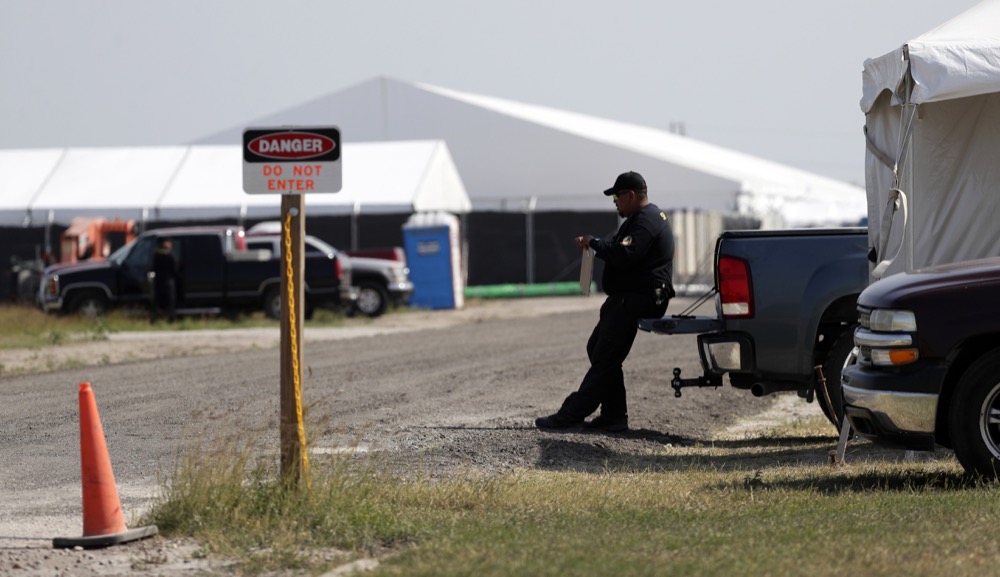 In this Wednesday, May 1, 2019, photo, a U.S. Customs and Border Protection temporary facility is prepared near the Donna International Bridge, in Donna, Texas. Officials say the site will primarily be used as a temporary site for processing and care of unaccompanied migrant children and families. (AP Photo/Eric Gay)
In this Wednesday, May 1, 2019, photo, a U.S. Customs and Border Protection temporary facility is prepared near the Donna International Bridge, in Donna, Texas. Officials say the site will primarily be used as a temporary site for processing and care of unaccompanied migrant children and families. (AP Photo/Eric Gay)
In a statement, the Border Patrol said the tents were built "to support efforts to process, care for and transfer the unprecedented number of families and unaccompanied children crossing the border illegally each day in a humane way, consistent with our border security mission and our American values."
The Border Patrol is supposed to keep people in custody for no more than three days, but migrants are sometimes detained for longer. Goodwin said she had spoken in the last week to a Guatemalan man who had been in a "hielera" for 12 days. The Border Patrol stations that house the "hieleras" will continue being used.
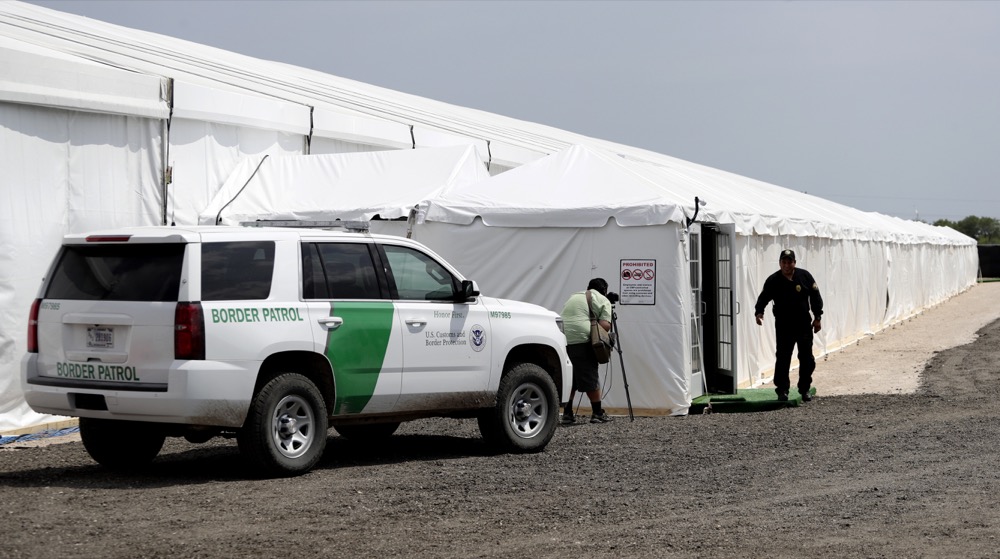 A security guard enters a new U.S. Customs and Border Protection temporary facility near the Donna International Bridge, Thursday, May 2, 2019, in Donna, Texas. Officials say the site will primarily be used as a temporary site for processing and care of unaccompanied migrant children and families and will increase the Border Patrol's capacity to process migrant families. (AP Photo/Eric Gay)
A security guard enters a new U.S. Customs and Border Protection temporary facility near the Donna International Bridge, Thursday, May 2, 2019, in Donna, Texas. Officials say the site will primarily be used as a temporary site for processing and care of unaccompanied migrant children and families and will increase the Border Patrol's capacity to process migrant families. (AP Photo/Eric Gay)
In some ways, the tents are better than the iceboxes, Goodwin said. "But that's not saying much."
Tent facilities previously used to detain migrants in Texas have often lacked adequate space or facilities, said Goodwin, a longtime attorney in Harlingen, Texas. A separate tent city near El Paso housed more than 2,700 migrant children before being shut down in early January amid security concerns.
It's unlikely that the new tent facilities will allow the Border Patrol to reopen the checkpoints or to stop reliance on the "hieleras" or the more hastily constructed, smaller tents.
The new 500-person tent in El Paso will only help the Border Patrol keep up, Cordero said, and the checkpoints can only be reopened if the flow of migrants slows down.
